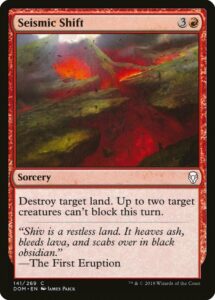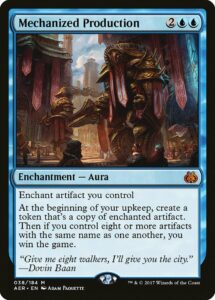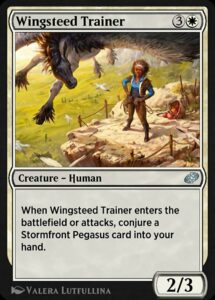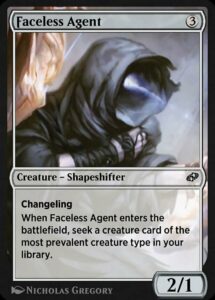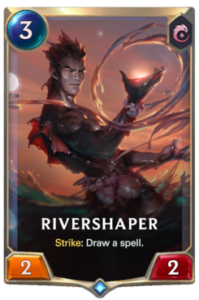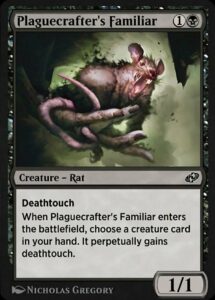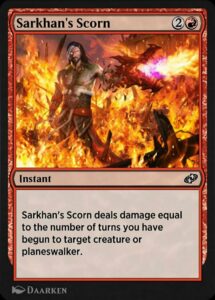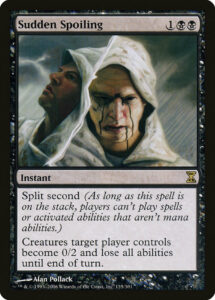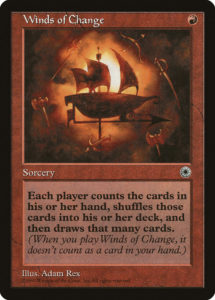Magic Arena is taking another big step with Jumpstart: Historic Horizons, releasing in just over two weeks. It will add hundreds of new cards to Arena, including 31 brand new cards and three brand new mechanics designed to function only in digital Magic: seek, conjure, and perpetually.
There’s a lot to consider with this announcement, so we’ll focus on just four key matters: How big of a change is this? How are these three new mechanics? Why add these cards to Historic? What does this mean for Magic?
How surprising is this?
Before yesterday, Magic Arena was mostly a platform for people to play the exact same game they can play on Magic Online or via tabletop Magic. Adding new digital-only cards and mechanics suggests that Arena is increasingly becoming its own thing, with its own form of Magic. Perhaps it will eventually split from tabletop Magic altogether, using its own formats with Arena-only cards and rebalanced cards that are banned or underperforming in paper. Where last week, local game stores might’ve been planning to hold Historic events, Historic is no longer intended as a tabletop format. At first blush, this seems like a sea change.
While Jumpstart: Historic Horizons is a very visible step towards Magic Arena diverging from tabletop Magic, but it’s by no means the first step. Arena has already toyed with live balance in last month’s Mirror, Mirror event. Historic has always contained cards like our good friend, Mardu Outrider that were never legal in paper play. Magic Arena has always offered unique modes of play with its focus on best-of-one, its use of draft bots, and regularly adding cards via Historic Anthology and Jumpstart.
And, as Barry White chronicled, Magic has been regularly making digital-only cards since 1997. So, while Jumpstart: Historic Horizons might seem like a drastic departure, it’s very much in line with prior choices. That doesn’t mean this isn’t a big change (it is, after all, a massive expansion for Historic) or that Magic Arena won’t one day be a similar-yet-distinct game from tabletop Magic, but this change also isn’t unprecedented.
How about those new mechanics?
In talking with Aaron Forsythe for IGN, Tom Marks aptly describes these three new mechanics as “tame.” All three are mainstays of digital card games like Legends of Runeterra, Hearthstone, and Eternal. It makes sense for Wizards to gently dip its toe into the water of digital-only mechanics before really innovating. It gives them time to gauge player reactions—how people actually behave once these cards are available, rather than how people instinctively and emotionally react when presented with sudden change.
All that being said, we’ve got a whole bunch of new designs and mechanics to consider, and I live for the intersection of Magic and game design.
Conjure
Conjure looks to be an incredibly flexible mechanic. It can be as simple as Wingsteed Trainer adding a Stormfront Pegasus to your hand, as varied as Tome of the Infinite generating one of ten random spells à la Garth One-Eye (but without forcing you to cast it immediately), or even being Magic’s take on Discover, a polarizing and beloved mechanic that helps digital card games balance for best of one. At present, only three Conjure cards are spoiled and all Conjure to your hand, but there may come a time when one can Conjure and immediately cast cards.
I love mechanics that create cards in your deck that didn’t start there. While there are major balance issues when every deck can create sideboard cards, early interaction, and finishers on demand, there’s nevertheless something exciting about your deck being bigger than the cards within it. It’s why Lessons are one of my favorite mechanics of the past decade.
Seek
Tutors are inherently problematic since they homogenize gameplay, making decks overly consistent. Replacing tutors with Impulse effects introduces different issues. Seek opts for a different path, letting players tutor with no control and no need for shuffling. It’s another common digital CCG mechanic, as seen on Legends of Runeterra’s Rivershaper.
Seek presents a deckbuilding puzzle—you maximize consistency by minimizing the number of viable targets, but doing so increases the chances of having nothing to seek and denies you a toolbox of targets. It’s another mechanic that has served digital games well, albeit one that needs be done in moderation to avoid the problems of tutors. The big concern Seek evokes actually has nothing to do with the mechanic, but with the templating on Faceless Agent.
An advantage of digital card games is clean and concise text, at the cost of some ambiguity. Most games have accepted that a little experimentation or Wiki-ing is acceptable if it means cards never have more than a couple lines of text. Magic cards have never had this luxury and are written in Magic-ese (see Dragon’s Fire for an incredibly wordy card yet simple design). Digital cards could have cleaner text boxes, but Faceless Agent still reads like a normal Magic card, for better or worse.
“Perpetually”
Magic has a rule that when a card changes zones, it becomes a new object. It loses all modifications and nothing remembers it (outside of specific effects like Oblivion Ring). Well, now you can make permanent modifications that persist across zones, including hidden zones like your hand and library.
The name is a bit unfortunate. Sadly, Magic can’t say an effect is permanent (since that’s a card type) and has to specifically enumerate an ongoing effect (since effects otherwise aren’t perpetual). “Perpetually” just makes for a weird mechanic name, like how Flying really wants to be named Flight (creatures have Trample and Deathtouch, not Trampling and Deathtouching).
This is another staple mechanic in digital card games, where cards can be buffed in your hand or deck before eventually being played. Interestingly, Magic followings the lead of Eternal (where changes persist across all zones) and not Legends of Runeterra or Hearthstone (where changes disappear when a creature leaves the battlefield). Magic and Eternal both employ graveyards and use graveyard recursion, while LoR and HS keep their screens less cluttered by having hidden discard zones and scant interaction with dead cards. There’s a lot of potential design space here—Eternal’s very first expansion proved that there is amazing design space, so it’ll be interesting seeing where Magic goes.
Other Affordances
Magic can’t have many cards like Serra Avenger or Control Win Condition, since it forces players to track information that rarely matters (and creates unverifiable board states). Digital rule engines solve that problem, enabling clean designs like Sarkhan’s Scorn that simply wouldn’t work in tabletop. There is ample design space here and I’m excited to see what the brilliant minds at Wizards do, both in their cautious first foray and what’s already been designed but not yet announced.
Overall, if I just look at the mechanics and the designs they enable, I. Am. Excited. There’s so much possibility space here, so much that Wizards has hitherto left to its competitors, and so much potential for synergy with what Magic has already done. But these designs don’t exist in vacuum—they’re being added to Historic, a format radically reshaped a few months ago by the Strixhaven Mystical Archive.
But why add these to Historic?
It may seem odd for Wizards to announce they’re moving in a new direction and impose that decision upon players—but it’s not. They do that with every release. Every set introduces new mechanics and powerful new cards. Standard players didn’t get to opt out of playing against Bonecrusher Giant, nor do Historic players get to opt out of playing against Faithless Looting. Historic is the format defined by regular infection of cards regularly—consider every Historic Anthology. Wizards is doing what they’ve done for twenty eight years and added new cards to an existing format.
One could credibly argue that Wizards ought to be as restrained with the implementation of Jumpstart: Historic Horizons as its mechanics. Why not introduce a new format to exist alongside Historic (let’s call it, er, Universal) that contains these brand new kinds of designs? Well, Arena has a problem: it has both too many and two few formats. Because it accommodates players who prefer best-of-one & best-of-three, ranked & unranked play, and human drafts & bot drafts, it fractures the playerbases of all of its formats.
At some point, there won’t be enough people playing every format at every time of day, meaning there won’t be enough opponents to play against. When a format suffers from a downturn, then player fragmentation exacerbates the trend. And that’s not even mentioning how overwhelming it can be for a player (new or otherwise) presented with 30+ options that are different flavors of five formats. Creating Universal, a format that’s “Historic, but 31 more cards” is likely to cause more problems than it’ll solve—and I’m happy they’re not eliminating BO3 Historic to make room for it.
If the response is poor or split, it won’t be hard for Wizards to backpedal and ban digital-only cards or create Universal later on. But it makes sense for them to do what they’ve always done and new cards to the platform’s nonrotating format.
What’s going to happen to Magic?
Change is hard. I got held back in school at four years old because I couldn’t handle it. I don’t know what Magic is going to look like in three years’ time. I can’t confidently say that Arena will always faithfully present a digital version of tabletop Magic, or that tabletop Magic will never go extinct. But I also recognize that for any creative endeavor, to stay the course is to stagnate and die. Experimentation, innovation, and reinvention are essential to survival, something Magic reminds us with every expansion.
At the end of the day, it makes sense for Magic Arena to chart its own course. The platform owes its success to making Magic easier to play, cheaper to access, and more similar to the successful digital card games built in Magic’s image. Arena brought Magic to players who otherwise wouldn’t be playing, not just cater to existing players. Magic should build upon the success of other digital card games (they built upon its foundation). Adding staple digital CCG mechanics makes good sense.
Arena and tabletop Magic might well diverge, but I find it hard to believe that tabletop Magic is going anywhere any time soon. First, consider Commander. Magic’s most popular format isn’t playable on Arena and may never be—imagine trying to make a user interface for four battlefields viable on a smartphone. Maybe one day we’ll have holographic glasses, AR projectors, or UI innovations that’ll make it easy, but we’re not there. Secondly, tabletop Magic is huge! I can imagine Wizards of the Coast closing up shop if tabletop games were dying out, but they’re thriving! I find it hard to believe they’d abandon a profitable physical market, leaving a massive void for competitors to fill.
Change is coming to Magic: the Gathering. This is true every other month with each booster expansion and every other week with a new Secret Lair. Magic is a bigger game than it has ever been due to three things: designing for more diverse audiences, constant experimentation, and damned good game design. Yesterday’s announcement is just another step forward—if it works out, great. If it doesn’t, also great—Wizards is in business because it’s in the business of listening to its players. And if it’s polarizing, the same applies. Here’s looking forward to the future, come what may.
Zachary Barash is a New York City-based game designer and the commissioner of Team Draft League. He designs for Kingdom Death: Monster, has a Game Design MFA from the NYU Game Center, and does freelance game design. When the stars align, he streams Magic (but the stars align way less often than he’d like).

